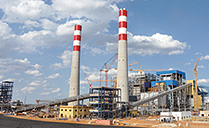Sinomach's hydropower project is go-ahead for green development
(sinomach.com.cn)
2022-03-11China is ready to make a greater contribution to the global response to climate change. As such, the country is taking concrete steps to foster green, low-carbon, high-quality development as it embarks on a path toward carbon peaking and neutrality.
By the end of 2021, China's installed renewable power-generating capacity had reached 1.06 billion kilowatts, accounting for 44.8 percent of its total installed power-generating capacity. China has led the world in the sectors of hydroelectricity, wind electricity, solar power and nuclear power. Meanwhile, it is committed to leveraging its resources and strengths to help BRI participants build their clean-energy industries and add momentum to local green development.
The Cambodian Tatay Hydropower Station, a China-Cambodia cooperative project undertaken by Sinomach subsidiary China National Heavy Machinery Corporation (CHMC), is one of those clean-energy projects. It was built on the fast-flowing Tatay River in Koh Kong, Cambodia. The station started operations in 2014, and had generated seven billion kilowatt-hours of electricity as of October 2021.
"The Tatay Hydropower Station has played a big part in ensuring electrical safety and dampening electricity price pressure. It greatly helps boost socio-economic development, and especially poverty reduction," said Cambodian Prime Minister Hun Sen.
By the end of 2020, Chinese enterprises had completed 10 hydro-electric stations in Cambodia, accounting for nearly 45 percent of the country's total installed capacity. Chinese-funded hydropower stations not only alleviate the energy shortage in the country, but also contribute to local energy conservation and emission reduction, according to Zhao Wensheng, deputy general manager of Cambodian Tatay Hydropower Limited, a local affiliate set up to maintain operations of the station.
Inefficient power delivery used to be a weakness of Cambodia's power system, and Chinese builders tailored targeted solutions. For example, CHMC has undertaken 13 power transformer projects and 34 substations in Cambodia, and the resulting line network now occupies more than half of the total length of Cambodia's national power grid.
The Stung Treng Hydropower Station, one of thoe projects, built Cambodia's first 500-kilovolt power transformer lines, which stretches to the border with Laos and has paved the way for electricity interconnection between Cambodia, Laos, Thailand and Vietnam.

 R&D and Manufacture
R&D and Manufacture Project Contracting
Project Contracting Trade and Services
Trade and Services




